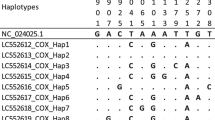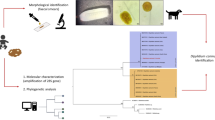Abstract
Babesia ovata and Babesia major are two newly identified large Babesia species infective to cattle in China. There is a demand for specific tools for discrimination between the two species due to the confusion of their classification based on traditionally classification methods, such as tick vector, morphology, and pathogenicity. In this study, the internal transcribed spacers (ITS including ITS1, 5.8S coding region and ITS2) were originated from four isolates of B. ovata and one of B. major from different geographic regions of China, and a phylogenetic tree was inferred. It was demonstrated that all of the four isolates of B. ovata were grouped into one cluster, while B. major isolate was placed in another. The sequence percent identity showed that B. ovata isolates had the minimum 85.5% identity, whereas B. major showed only the maximum 46.6% identity to the four B. ovata isolates. In addition, the identity of ITS1 and ITS2 of these Babesia isolates was discussed. The findings implied that the four B. ovata isolates have a quite close relationship, whereas the B. major isolate showed far relationship with all of these B. ovata isolates. This finding may lead to the conclusion that there is actual existence of two large Babesia infective to cattle in China, one is B. ovata and the another is B. major.

Similar content being viewed by others
References
Bai Q, Liu GY, Zhang L, Zhou JY (1990) Discovery and isolation of Babesia ovata in China (in Chinese). Chin J Vet Sci Technol 12:2–4
Bai Q, Liu GY, Han GF, Hui Y (1994) Isolation and complementary transmission of Babesia ovata in Zhangjiachuan of Gansu Province. Chin J Vet Sci Technol 24:9–10
Baneth G, Kenny MJ, Tasker S (2004) Infection with a proposed new subspecies of Babesia canis, Babesia canis subsp. presentii, in domestic cat. J Clin Microbiol 42:99–105
Brockiesby DW, Barnett SF (1970) Large Babesia species transmitted to splenectomized calves by field collections of British ticks (Haemaphysalis punctata). Nature 228:1215
Higuchi S, Bai Q, Liu DC, Wang XL, Yan ZT (1991) Studies on Babesia sp. isolated from cattle in Henan, China (in Chinese). Bull Vet Coll PLA 11(1):63–67
Holman PJ, Bendele KG, Schoelkopf L, Jones-Witthuhn RL, Jones SO (2003) Ribosomal RNA analysis of Babesia odocoilei isolates from farmed reindeer (Rangifer tarandus tarandus) and elk (Cervus elaphus canadensis) in Wisconsin. Parasitol Res 91:378–383
Liu AH, Luo JX, Yin H, Guan GQ, Ma MK, Dang ZS, Liu ZJ, Ren QY, Li YQ, Liu JL, Shi YX, Fan RQ, Wang F, Bai Q (2006) Isolation and identification of two Piroplasma species from Wenchuan county in Sichuan. Chin J Vet Sci 36:972–975
Lu WS, Yin H, Lu WX, Yu F, Zhang QC, Dou HF (1988) Discovery of Babesia major from cattle in Henan, China (in Chinese). Chin J Vet Sci Technol 12:11–14
Lu WS, Yin H, Lu WX, Yu F, Zhang QC, Dou HF (1992) Discovery of Babesia major in Xinjiang (in Chinese). Symposium of the 3rd Meeting of Chinese Society of Veterinary Parasitology, p 220
Luo JX, Yin H, Guan GQ, Yang DY, Liu AH, Ma ML, Liu ZJ, Dang ZS, Bai Q, Lu WS, Chen PY (2005) A comparison of small-subunit ribosomal RNA gene sequence of bovine Babesia species transmitted by Haemaphysalis spp. in China. Parasitol Res 95:145–149
Luo JX, Yin H, Liu GY, Guan GQ, Liu ZJ, Liu AH, Bai Q, Lu WS (2006) Collection and identification of Piroplasma infected to cattle and sheep in China (in Chinese). Chin J Parasitol Parasit Dis 24:S48–S53
Minami T, Ishihara T (1980) Babesia ovata sp.n. isolated from cattle in Japan. Natl Inst Anim Health Q (Tokyo). 20(3):101–13
Morzaria SP, Brocklesby DW, Harradine DL (1977) Experimental transmission of Badesia major by Haemaphysalis punctata. Res Vet Sci 23:261–262
Yin H, Lu WS, Luo JX, Zhang QC, Lu WX, Dou HF (1996) Experimental transmission of Babesia major and Babesia bigemina by Haemaphysalis punctata. Vet Parasitol 67:89–98
Yin H, Lu WS, Zhang QC, Lu WX, Luo JX, Liu QY, Du ZM (2000) Experimental transmission of some bovine and ovine tick borne haemoprotozoans in Gansu province (in Chinese). Chin J Vet Sci Technol 8:17–19
Zahler M, Gothe R, Rinder H (1995) Genetic evidence against a morphologically suggestive conspecificity of Dermacentor reticulates and D. marginatus (Acari: Ixodidae). Int J Parasitol 25:1413–1419
Zahler M, Schein E, Rinder H, Gothe R (1998) Characteristic genotypes discriminate between Babesia canis isolates of differing vector specificity and pathogenicity to dogs. Parasitol Res 84:544–548
Acknowledgments
This study was supported by the National Natural Sciences Foundation of China (No. 30571397) and the Natural resource platform project (No. 2005DKA21104). The authors would like to thank Dr. D. A. Salih, Central Veterinary Research Laboratories, Al amarat, Khartoum, Sudan for his critical correction of and comments on this draft.
Author information
Authors and Affiliations
Corresponding author
Rights and permissions
About this article
Cite this article
Liu, J., Yin, H., Liu, G. et al. Discrimination of Babesia major and Babesia ovata based on ITS1–5.8S–ITS2 region sequences of rRNA gene. Parasitol Res 102, 709–713 (2008). https://doi.org/10.1007/s00436-007-0818-y
Received:
Accepted:
Published:
Issue Date:
DOI: https://doi.org/10.1007/s00436-007-0818-y




